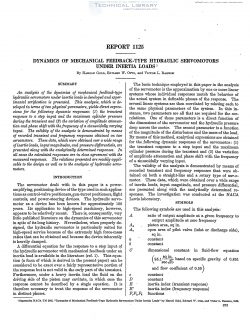naca-report-1125
- Version
- 127 Downloads
- 2.29 MB File Size
- 1 File Count
- October 27, 2016 Create Date
- October 27, 2016 Last Updated
National Advisory Committee for Aeronautics, Report - Dynamics of Mechanical Feedback Type Hydraulic Servomotors Under Inertia Loads

The servomotor dealt with in this paper is a power-
amplifying, positioning device of the type used in such applica-
tions as control-valve positioners, gun-turret positioners, flight
controls, and power-steering devices. The hydraulic servo-
motor as a device has been known for approximately 100
years. Its application to high—speed machinery, however,
appears to be relatively recent. There is, consequently, very
little published literature on the dynamics of this servomotor
in spite of its long history. Nevertheless, when properly de-
signed, the hydraulic servomotor is particularly suited for
high-speed service because of the extremely high force-mass
ratios that can be obtained and because the device inherently
is heavily damped.
A differential equation for the response to a step input of
the hydraulic servomotor with mechanical feedback under an
inertia load is available in the literature (ref. 1). This equa—
tion (a form of which is derived in the present paper) can be
considered to be exact over a fairly representative portion of
the response but is not valid in the early part of the transient.
Furthermore, under a heavy inertia load the fluid on the
driving side of the piston may cavitate, in which case the
response cannot be described by a single equation. It is
therefore necessary to treat the response of the servomotor
in distinct phases.
e basic technique employed in this paper in the analysis
of the servomotor is the approximation by one or more linear
systems whose individual responses match the behavior of
the actual system in definable phases of the response. The
several linear systems are then correlated by relating each to
the same physical parameters of the system. In this in-
stance, two parameters are all that are required for the cor-
relations. One of these parameters is a direct function of
the dimensions of the servomotor and the hydraulic pressure
drop across the motor. The second parameter is a function
of the magnitude of the disturbance and the mass of the load.
By means of this method, analytical expressions are obtained
for the following dynamic responses of the servomotor: (1)
the transient response to a step input and the maximum
cylinder pressure during the transient and (2) the variation
of amplitude attenuation and phase shift with the frequency
of a sinusoidally varying input.
| File | Action |
|---|---|
| naca-report-1125 Dynamics of Mechanical Feedback Type Hydraulic Servomotors Under Inertia Loads.pdf | Download |

Comment On This Post